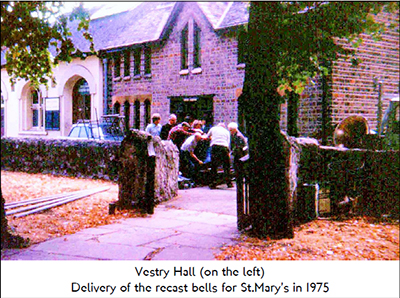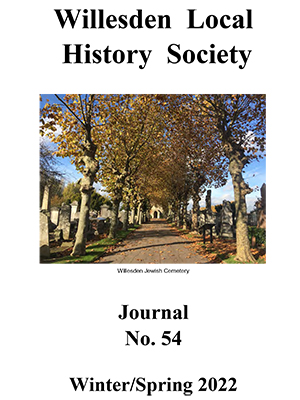Gwen Bennett Molloy, WLHS Journal, No. 20, 2004/5, and in the Willesden Local History Society – 40 Years of History
Although the Society did not come into existence until 1974, the early seeds were sown when the splendid late Victorian Willesden Town Hall in Dyne Road was demolished. Attempts to save it were made by the late Cllr. Ivor Davies, aided by two or three who later came into the Society. But, despite Cllr. Davies being chairman of the Planning Department, the Council was determined to erect housing on the site and that is what happened.
By 1974 Cllr. Davies had approached a few people now interested to record Willesden’s historical buildings before they vanished, and the history of the area. This was made possible as a Chairman of the Willesden Local Board, Frederick Augustus Wood, and his Clerk, Stanley Ball, kept many records of interest that related to Willesden. These could form the nucleus of further research, and be of interest to residents, ex-residents, and others.

A Steering Committee was formed with Cllr. Davies as chairman and his wife Betty acting as secretary. By May 1974 the late Robin Oakley, son of the Rural Dean and incumbent of St.Mary’s Church, gave a tour of the Church in which, as a historian, he had taken much interest. In October he followed it up with a talk in Vestry Hall which was to become our meeting place for the early years. The Rural dean’s wife, Joan Oakley, served tea and biscuits.
After we had to leave the Vestry Hall we moved from one place to another, mostly function rooms in public houses and eventually to Willesden Library and Arts Centre.
In our first year we had a talk on Willesden Street Names which elicited interest from several Councillors. But they didn’t reappear, perhaps because the Vestry Hall was not available and we had to sit on benches in an upper room in the Church. There were several occasions when meetings had to be at the Church but using the pews which were more comfortable than the benches.
Publicity in the local papers was too expensive, but this was overcome by the Society contributing an account of our talks followed by the date of the next meeting. Several people who became members had lived in Willesden and this ‘country membership’ often sent in their memories of the area.
In the early days no speaker charged a fee although we would offer expenses. We could ask speakers who were distinguished in their area of research like Eric Simms the ornithologist and film maker of bird life for the BBC, and Michael Robbins who was chairman of LPT13 and author of the definitive local history of Middlesex. By 1976 the new Local History Museum was opened by the then Mayor Cllr. Len Snow and, although not conveniently sited at Neasden, provided access to the archives. Val Bott, the curator, and Judith Knight, the archivist, were a source of constant assistance and stayed for several years, unlike their many successors.
The December meeting was always held at the Grange when Val and Judith provided mince pies and a competition to test our local history knowledge. Sometimes the Naimaster collection was laid out. This collection of photos, press-cutting, paintings etc. was collected by an antiques specialist who kept everything relating to Willesden (where he was born) that passed through his shop. Later the Naimaster archive was acquired by Brent Borough Council.
For many years we shared a meeting with Wembley History Society alternating between the two venues with two speakers from each Society. It is not clear why these petered out, – a pity as Wembley had some members highly knowledgeable about the area, eg. the aircraft factories, Wembley Parish Church, the founder of the Express Dairy, the Sister and Benefactors of Wembley Hospital, and others.

One early visit was to Twyford Abbey on the Willesden/Acton border. We hired a coach which was costly and few people came. The Brother who showed people round was not there and the Anglican Church on the Guinness estate had a wedding in progress! This visit taught us a few lessons. Later we revisited and Brother Cornelius was there to show us the fine house (which is now is in a sad state of decay) and the typically Roman Catholic chapel which was available to residents of the Guinness estate.
Val Bott contributed many talks on people, homes, parks of the area, and on Willesden High Road. When this writer was to speak on Kilburn High Road, the function room was double booked so the talk was given in the bar above the racket in there.
The Welsh Harp was the subject of more than one talk followed by a muddy walk round it. Kensal Green Cemetery has been visited more than once by the Society, each time led by a different local historian, and we have also received a formal talk on its history.
Among the talks of the first 10 years that by James Crook, the fifth generation of the Kilburn undertakers, was memorable for his many historical photographs. Among his several talks was one on the formation of the parishes from the original parish of St.Mary’s. He presented this as a kind of jigsaw puzzle with a cut-out of each parish as it was sliced off until all the parishes were in place.
Transport was a popular topic. John Huntley invited all his friends to his talk ‘Transport in the Borough of Brent’ and WLHS members could not be admitted as the fire regulations stipulated the Museum was filled to the safety limit. Ken Valentine produced a Magazine which was published from 1983 to 1992. It was informative and always correct but found wanting by some members as there was never anything visual by way of maps, drawings or brass rubbings. He gave a talk on the War in Willesden, covering two meetings, but the first half of one meeting was devoted entirely to the V1 launching pads at Peenemunde, found tedious by several members. But, like everything he wrote, it was painstakingly researched.
When this writer spoke on Brondesbury & Kilburn High School several members who were old pupils attended and were very interested in a reminder of it. The early history of the school was included in Irene Lilley’s talk on Maria Grey College. She was author of a book on the history of the school that was created to provide student teachers with teaching practice.
At Annual General Meetings, not well attended in the early days, some members provided sandwiches and a cider cup. They were very sociable occasions! There were many other meetings such as Terry Lomas with his music hall songs, Bob Hyatts’s projection of his splendid collection of old postcards of the area, a visit to Willesden’s Jewish Cemetery, and a talk on the Jewish community in the City of London. It was not envisaged the Society would survive so long and the programme was supplemented with subjects from outside the Willesden area. In the early days the committee was not so aware of the sources of speakers on local topics.
Today there is much more awareness and interest in local history for which television and radio has played a large part. This article has dealt only with the first ten years and the Society can well look forward to a full future with all the meetings based on Willesden alone.









